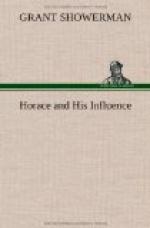The data regarding Horace in the Middle Age are few, but they are clear. We need not examine them all in order to draw conclusions.
The monastic idea, of eastern origin and given currency in the West by Jerome, was first reduced to systematic practice by Benedict, who created the first Rule at Monte Cassino about the time of the Mavortian recension of Horace, in 527. New moral strength issued from the cloisters now rapidly established. Cassiodorus, especially active in promoting the spiritual phase of monkish retreat, made the intellectual life also his concern. Monte Cassino, between Naples and Rome, and Bobbio, in the northern part of the peninsula, were the great Italian centers. The Benedictine influence spread to Ireland, which before the end of the sixth century became a stronghold of the movement and an inspiration to England, Germany, France, and even Italy, where Bobbio itself was founded by Columban and his companions. St. Gall in Switzerland, Fulda at Hersfeld in Hesse-Nassau, Corvey in Saxony, Iona in Scotland, Tours in France, Reichenau on Lake Constance, were all active centers of religion and learning within two hundred years from Benedict’s death.
The monasteries not only afforded the spiritual enthusiast the opportunity of separation from the world of temptation and storm, but were equally inviting to men devoted first of all to the intellectual life. The scholar and the educator found within their walls not only peaceful escape from the harshnesses of political change and military broil, but the opportunity to labor usefully and unmolested in the occupation that pleased them most. The cloister became a Christian institute. The example of Cassiodorus was followed two hundred years later on a larger scale by Charlemagne. Schools were founded both in cloister and at court, scholars summoned, manuscripts copied, the life of pagan antiquity studied, and the bond between the languages and cultures of present and past made firmer. The schools of the old regime had fallen away in the sixth century, when Northern rule had closed the civic career to natives of Italy. A great advance in the intellectual life now laid the foundations of all cultural effort in the Middle Age.
No small part of this advance was due to the preservation of manuscripts by copying. In this activity France was first, so far as Horace was concerned. The copies by the scribes of Charlemagne went back to Mavortius and Porphyrio, the originals of which were probably discovered at Bobbio by his scholars. Of the two hundred and fifty manuscripts in existence, the greater part are French in origin, the oldest being the Bernensis, of the ninth or tenth century, from near Orleans. Germany was a worthy second to France. The finds in monastery libraries of both countries in the humanist movement of the fifteenth century were especially rich. Italy, on the contrary, preserved few manuscripts of her poet, and none that is really ancient. Italy began the great monastery movement, but disorder and change were against the diffusion of culture. Charlemagne’s efforts probably had little to do with Italy. The Church seems to have had no care to preserve the ancient culture of her native land.




